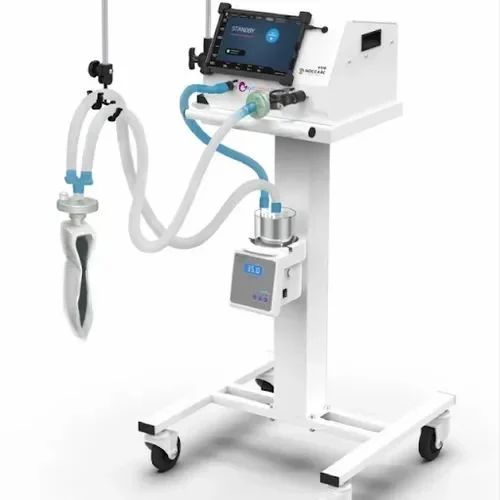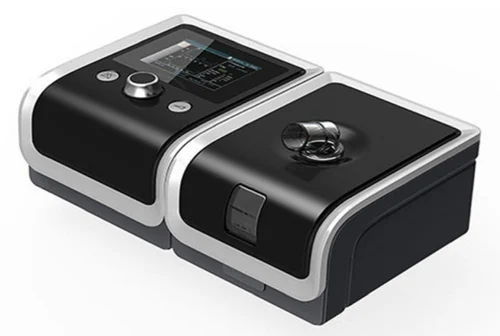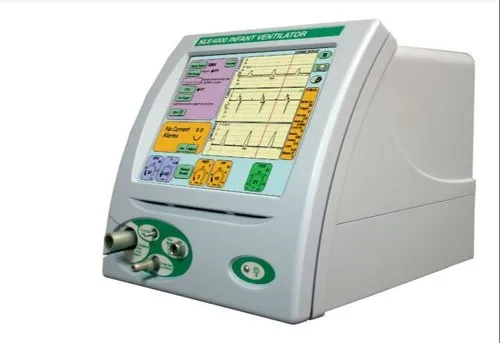Neonatal Ventilator
Main benefits of PSV:
- Reduced WOB
- Improved infant/ventilator synchrony
- Reduced need for sedation
- Retraining of respiratory musculature
- Reduced time to wean
- PSV is designed and used in the weaning process and can be used with or without Synchronous Intermittent Mandatory Ventilation (SIMV).
Do you want to make Product
Inquiry
Description
Product Specification
| Voltage | 100-250 V |
| Frequency | 50-60 Hz |
| Power | 115 VA |
| Battery Back up | 45-60 minutes |
| Battery Charging | Full charge 24 hours, 80% charge after 8 hours |
| Outputs | RS-232C |
| Air and O2 Input Pressures | 3-5 bar |
| Fresh Gas Flow | 8 litres/min |
| Maximum Gas Flow | 60 litres/min |
| Operating Environment Temperature | 10-40 Degree C |
| Humidity | 0-90% (non-condensing) |
| Apnoea Time Range | 3 to 60 sec |
| Apnoea Time Resolution | 1 second |
| High Minute Volume Range | 0.02 to 18 litres |
| High Minute Volume Resolution | 0.1 litre |
| Low Minute Volume Range | 0 to 0.02 litres below High Minute Volume threshold |
| Low Minute Volume Resolution | 0.1 litre |
| Low Tidal Volume Range | 0 to 200 ml |
| Low Tidal Volume Resolution | 0.2 ml |
| Dimensions Ventilator only | 330mm W x 330mm H x 470mm D |
| Weight, Ventilator only | 23.6 kg |
| Height on Tall Stand | 131 cm |
| Height on Short Stand | 114 cm |
Product Description
SLE is a world leader in the design and manufacture of neonatal ventilators. Years of ventilation experience have given the company an understanding of the challenges facing clinicians when caring for the tiniest and most critical babies. From being pioneers of neonatal Patient Triggered Ventilation (PTV) in the 1980’s, to the introduction of combined HFO (High Frequency Oscillation) in the 1990’s, SLE has maintained a position of leadership in neonatal ventilation. The company’s guiding principle is to support clinical and nursing staff in their everyday work. SLE has developed close relationships with leading universities, hospitals and other specialists and has created a ventilator that meets the highest standards using innovative solutions to clinical challenges. The knowledge and experience gained during years of development is evident in the SLE4000 ventilator; the result of SLE’s ongoing commitments to innovation, competency and care
Modes Include:
- CPAP, CMV+ TTV, PTV, PSV, SIMV+ TTV + PSV,
- Ability to preset parameters in all modes of operation
- Full colour, total touch-screen operation
- Integral flow monitoring measuring lung mechanics and displaying of loops and waveforms
- Trending of measured parameters
- Standard patient circuit for all modes (Except with NO therapy)
- Unique, patented valveless technology
- Integral battery with up to 60 minutes operating capability
- Software based, allowing for upgrading to versions with new or improved functions
Targeted Tidal Volume (TTV):
- There is increasing clinical evidence to suggest that it is volutrauma that causes lung injury, which is worsened by barotrauma. It is also evident that efficient gaseous exchange is dependant on the delivery of appropriate tidal volumes.
- Targeted Tidal Volume enables the user to select a target volume that they wish to achieve, allowing the ventilator to adjust PIP and Ti to achieve and maintain the selected tidal volume.
Main benefits of TTV:
- Reduction in volutrauma
- A stable tidal volume accommodating changes in resistance and compliance
- A more stable PaCO2 resulting in reduced episodes of hypocapnia and hypercapnia
- Reduction in barotrauma
- Ability to self wean
Pressure Support Ventilation (PSV)
- In this mode of ventilation the infant has the ability to trigger and terminate every breath. The main aim of PSV is to reduce the ‘work of breathing’ (WOB) in the spontaneously breathing infant.
Main benefits of PSV:
- Reduced WOB
- Improved infant/ventilator synchrony
- Reduced need for sedation
- Retraining of respiratory musculature
- Reduced time to wean
- PSV is designed and used in the weaning process and can be used with or without Synchronous Intermittent Mandatory Ventilation (SIMV).
Respiratory Mechanics Measurements:
- Loops and waveforms allow the clinician to monitor and adjust ventilator strategy.
- Real-time lung dynamics
- Loops can be displayed in real time or frozen
- Breath-by-breath display of resistance, compliance and C10/C values
User Interface:
- Brightly coloured user touch screen. Easy-to-use, logical sequence allowing quick, smooth adjustments
Mode Panel:
The mode panel is the user’s interface to all mode related functions.
Audible and Visual Alarms:
- The alarm panel provides an immediate audible and pictorial view of the alarm condition, thus allowing easy monitoring, plus an alarm history of the last 100 conditions








